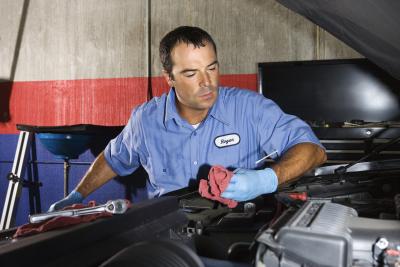
When diagnosing a Chevy HEI distributor, in the event of an ignition miss, the spark plugs and the spark plug wires should be inspected first to isolate the problem. The spark plugs should be removed, and the electrode and ceramic center should be examined. The main concern is the electrode for wear and gap. The ceramic core should be checked for coloration and carbon buildup. Any abnormalities are reason for replacement. The spark plug wires should be sprayed with water while the engine is running. Look for arcing to the block or any other metal surface. In lieu of arcing, the resistance should be checked for opens (separated cores) in the wires in which case there will be very high resistance.
Pull one or two spark plug wires from the distributor cap and check for corrosion. Clean or replace the cap if any is found.
Remove the distributor cap, using the Phillips head screwdriver. If the engine has an isolated-type misfire where one or more cylinders has a misfire (miss), it can be isolated to the plugs, wires or cap. Check the cap very closely for cracks and arcing between the poles. Replace if there are any abnormalities. If the miss is frequent and random, continue this diagnosis.
Connect the timing light. Attach the red alligator clip to the positive terminal of the battery and the black clip to the negative terminal. Make sure the wires are laying on the intake manifold where they will not fall into the fan or moving parts. Hook the inductive carbon clamp around the closest wire on either side of the motor. When the engine is running, point the light at the engine and watch the light. Look for a steady flash with no glitches or black outs. Move onto the next wire and so on, noting the cylinders that show a miss. The ones that exhibit a miss must be checked again for an electrical malfunction in either the wire, plug, cap, rotor or coil.
Spray each cylinder's exhaust manifold close to the head with water. The cylinders that are firing well will evaporate the water as fast as it hits the manifold. The weak cylinders will take a while to evaporate the water. Now that the misfiring cylinders are isolated, it must be determined whether the misfire is the distributor or component item, a bad fuel injector, or a mechanical internal problem such as a burnt or sticking valve or worn camshaft.
Check the weak cylinders using the spare spark plug by pulling the wire off the weak cylinder at the plug and inserting the spark plug into the wire. Lay the plug and wire on the block so it is grounded. Start the engine and watch the spark at the plug gap. If the spark is constant and strong with a blue look, replace the plug. If the spare plug shows little spark, swap the wire with a good cylinder and re-try. If it improves, replace the wires. If it does not improve, replace the cap. Before doing this, though, swap cylinders with the spare spark plug. Pull the plug out of the current wire and reinstall it, then pick a cylinder that is known to be good. Insert the plug and re-try. If the plug has a good constant spark, the misfire is definitely isolated.
Pull the electrical connector off the fuel injector on one of the weak cylinders and watch for a good drop in RPM. If no significant drop occurs, the injector should be replaced.
Shut the engine down and connect the timing light inductive carbon to the coil wire. Start the engine and watch the light for irregularities. If any exist, replace the coil.
Check the ignition control module if there is a persistent, continuous miss or no fire at all (a no start). With the key on, check the distributor plug for power. If there is power, replace the ignition control module.